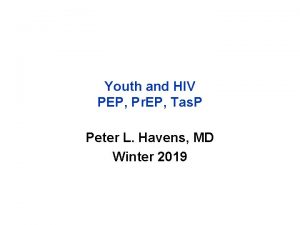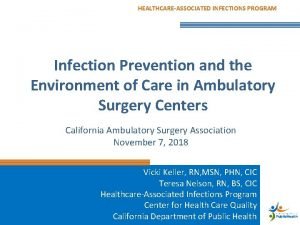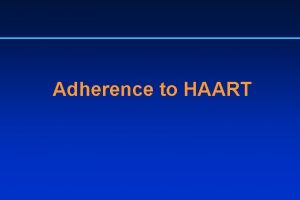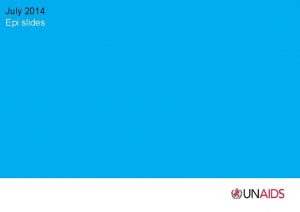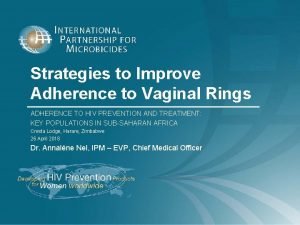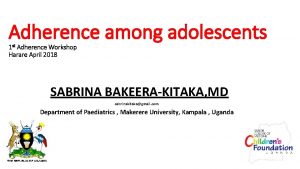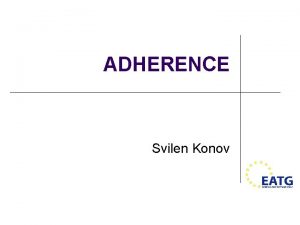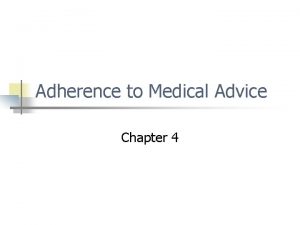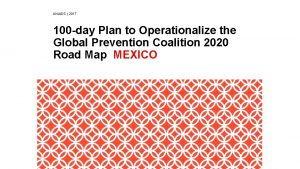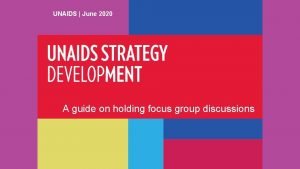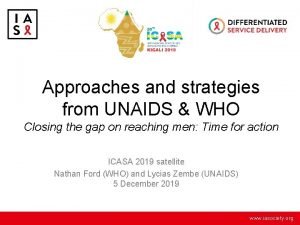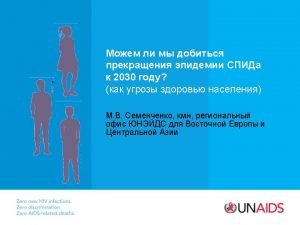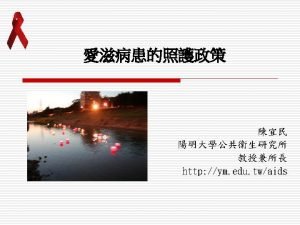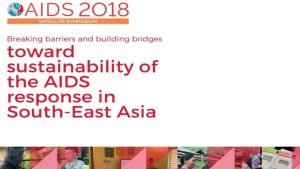UNAIDS JANUARY 2017 Presentation to Conference on Adherence






















- Slides: 22

UNAIDS | JANUARY 2017 Presentation to Conference on Adherence to HIV prevention and Treatment: Key populations in Sub – Saharan Africa PRESENTER NAME Boaz Cheluget Strategic Information Advisor UNAIDS

General background‐UNAIDS • UNAIDS leads the world’s most extensive data collection on HIV epidemiology, programme coverage and finance and publishes the most authoritative and up‐to‐date information on the HIV epidemic. • Under a mandate from the United Nations General Assembly, UNAIDS works with all countries to collect and analyze data on their AIDS responses and to help build the capacity to generate and use strategic information.

General background‐UNAIDS • UNAIDS data have been trusted and used by countries and organizations around the world to guide and monitor their responses to HIV since UNAIDS’ inception in 1996. • With concrete targets to be met on the way to ending the AIDS epidemic by 2030, it is vital to have the right data tracking whether the world is on course to meeting the commitments made in the 2016 United Nations Political Declaration on Ending AIDS.

General background-Global, East and South African region • Globally, 36. 7 million people are living with HIV with 20. 9 million (57 %) being antiretroviral therapy by July 2017. • During the same period 1. 8 million become newly infected. • In Zimbabwe it is estimated that 1. 3 million people are infected with HIV with slightly just over a million (77 %) currently receiving antiretroviral therapy. • It is recognized that ART averts deaths, improves quality of life as well as reduce infectiousness by PLHIV when adhered to.

General background-Global, East and South Africa region • There was a 50% increase in HIV‐related deaths in youth and adolescents (aged 10– 24) from 2005 to 2012. • This highlighted the need to improve HIV treatment and care in this population, including treatment adherence and retention. • Furthermore WHO guidelines on testing and treatment of youth and adolescents aged 10‐ 24 identified men who have sex with men (MSM), transgender persons, people who inject drugs (PWID), sex workers and prisoners as young key populations.

General background-Global, East and South Africa region • The term KP recognizes that people belonging to these groups are at heightened risk of contracting HIV due to specific behaviours, social and legal environments that affect negatively their ability to protect themselves; • Some reviewed articles recognize that in general adherence to prevention and treatment services is better than other regions notably United States. • It is generalized that around 1 in 4 achieve optimal adherence, risking drug resistance and negative treatment outcomes • Negative treatment outcomes specifically leads to 2 nd line treatments that is 10 times more expensive than 1 st line treatment.







Key indicators to monitor uptake and adherence of prevention and treatment services include – – – – Size estimate HIV prevalence Incidence Knowledge of status rate by the population Knowledge of status by the KP living with HIV ART coverage Adherence viral load suppression Condom use rate by risk behaviour Coverage of specific prevention interventions Avoidance of services due to stigma Clean needle use Safe injection

There is limited information on access and adherence to treatment by key populations in sub Saharan Africa. • Most information but very limited is available for sex workers • Some countries have reported populations size estimates of sex workers and include Angola, Botswana, Kenya, Madagascar, Mozambique, Namibia, Rwanda, Seychelles, Swaziland Zambia.

There is limited information on access and adherence to treatment by key populations in sub Saharan Africa. • Countries that do not have size estimates for sex workers include Zimbabwe, United Republic of Tanzania, Uganda, South Sudan, South Africa, Mauritius, Malawi, Lesotho, Ethiopia, Eritrea and Comoros. • The other key populations like people who inject drugs, gay men and other men who have sex with men, transgender people and prisoners have very limited disaggregated data;

There is limited information on access and adherence to treatment by key populations in sub Saharan Africa. • Most reported information is condom use by sex workers in Angola, Eritrea, Kenya, Lesotho, Malawi, Mauritius, Rwanda, Seychelles, Swaziland, Uganda, United republic of Tanzania, Zambia • Basic indicators like prevalence, knowledge of status, ART coverage, adherence and viral suppression cascades are virtually not reported by governments.

There is limited information on access and adherence to treatment by key populations in sub Saharan Africa. • Where it is reported HIV prevalence among key populations is higher than the PLHIV population. • Knowledge of status by sex workers is reported in Madagascar at 40. 6 % compared to 7 % for PLHIV, In Madagascar PWID has 20. 6 % knowledge of status, Gay men and MSM 19. 3 %.

There is limited information on access and adherence to treatment by key populations in sub Saharan Africa. • Mauritius report knowledge of status by sex workers 78. 9 %, PWID 71. 1 %, Gay men and MSM 86. 6 % compared to 31 % in the general population. • In Rwanda, knowledge of status by sex workers is 95. 1 % compared to 87 % by PLHIV • It is not possible to compare access and coverage for ART and adherence for key populations and the general populations.

Barriers to uptake and adherence reported • highly stigmatized may be contributing adhering to HIV treatment and services 1. • There are other influences that include access to healthcare, the burden of multiple vulnerabilities, policy involving risk behaviours and mental health 1 • Traditional medicine • psychosocial barriers, such as depression and anxiety, have consistently been found to have an adverse effect on adherence • other related costs such as transport expenditures, registration and user fees at the private health facilities, lost wages due to long waiting time in public hospitals

Barriers reported in national governments progress reports include • Community delivery systems are limited • Laws requiring parental consent for adolescents to access sexual and reproductive health services • Laws policies restricting entry, stay and residence of people living with HIV • Criminalization of transmission, non‐disclosure and exposures of HIV • Recommended CD 4 levels for treatment • Trips flexibility incorporated in the national legislation.

Conclusions • There is an urgent need for more systematic research in KP. – Research on KP could be used to inform future interventions to improve access to treatment and management of co‐morbidities related to HIV • Current limited evidence suggests that healthcare delivery should be tailored to the unique needs of KP. • Prioritizing addressing of stigma • Addressing legislative barriers that include Laws requiring parental consent for adolescents to access sexual and reproductive health services • There is an urgent need to identify context‐specific constraints to adherence and implement interventions to address them.

Asante Sana http: //www. unaids. org/
 Sex24x
Sex24x Unaids
Unaids January 25 2018 chemistry regents answers
January 25 2018 chemistry regents answers Adhérence préputiale traitement
Adhérence préputiale traitement Liaison par pincement
Liaison par pincement Liaison complète par tampons tangents
Liaison complète par tampons tangents Exercise adherence definition
Exercise adherence definition Exercise behavior and adherence
Exercise behavior and adherence Negative pressure room
Negative pressure room Arma conference 2017
Arma conference 2017 Cit international conference
Cit international conference Syteline user network conference 2017
Syteline user network conference 2017 2017 asco oncology practice conference
2017 asco oncology practice conference Njdv
Njdv Fetal brow
Fetal brow Fundal height transverse lie
Fundal height transverse lie He was born in salzburg austria on january 27 1756
He was born in salzburg austria on january 27 1756 Zodiac for january 20
Zodiac for january 20 Birth newton
Birth newton January february march april
January february march april January february maruary
January february maruary Nysedregents chemistry
Nysedregents chemistry Nysedregents
Nysedregents
